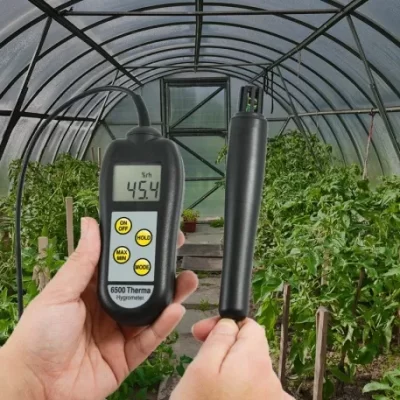Information
Understanding Humidity
Relative Humidity is the amount of water vapour in the air. As we hear on our weather reports, relative humidity is measured as a percentage of the maximum amount of water vapour the air can hold at the same temperature. The abbreviation for the measurement of relative humidity is %rh. This means the higher the humidity, the wetter it feels outside.
Then there is Dew Point. What needs to happen when your humidity is too high? The air temperature needs to drop, and this is called a dew point. Dew Point is the lower temperature to which air must be cooled for condensation [saturation] to occur. Dew point is dependent on the concentration of water vapour %rh is present.
Why would you want to measure relative humidity? You would want to measure %rh since many products can be sensitive to variations in humidity. Products such as fruit and vegetable storage facilities, greenhouses, tobacco curing, and handling facilities are humidity sensitive.

Here are some practical relative humidity examples:
If a building is too damp and the humidity level is above 70%rh, mould will develop, and it encourages dust mites to breed in carpets and mattresses. If the humidity level is too low below 25%rh it can cause respiratory discomfort.
In the agricultural sector, if conditions are too humid, it may promote the growth of mould and bacteria. This causes plants to die and crops to fail. It creates the perfect environment for conditions like root or crown rot. Humid conditions also invite the presence of pests, such as fungus gnats, whose larvae feed on plant roots and thrive in moist soil.
If humidity is very low and subsequent *transpiration is too high, the plant closes its stomatal openings to minimize water loss and wilting. Unfortunately, this also means photosynthesis is slowed and subsequently, so is plant growth.
* Transpiration is a process that involves the loss of water vapour through the stomata of plants. The loss of water vapour from the plant cools the plant down when the weather is very hot, and water from the stem and roots moves upwards or is ‘pulled’ into the leaves.

Now that we understand relative humidity and dew point, you can understand why it is so important for many environments to be monitored.
We have a selection of hygrometers that can assist you with the monitoring process of relative humidity and dew point. Whether you are monitoring the relative humidity in your wine cellar or greenhouse, incubator, sauna, warehouse, or museum we will have the instrument for you.
PMI Team is reachable on 011 728 6099 – call us to chat about your requirements.

